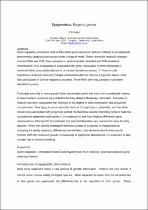JavaScript is disabled for your browser. Some features of this site may not work without it.
- ResearchSpace
- →
- Research Publications/Outputs
- →
- Journal Articles
- →
- View Item
| dc.contributor.author |
Fossey, A

|
|
| dc.date.accessioned | 2009-12-07T07:49:48Z | |
| dc.date.available | 2009-12-07T07:49:48Z | |
| dc.date.issued | 2009-06 | |
| dc.identifier.citation | Fossey, A. 2009. Epigenetics: beyond genes. Southern Forests, Vol.71(2), pp 121-124 | en |
| dc.identifier.issn | 2070–2620 | |
| dc.identifier.uri | http://www.ingentaconnect.com/content/nisc/sfjfs/2009/00000071/00000002;jsessionid=7ns41hkui7u7j.alice | |
| dc.identifier.uri | http://hdl.handle.net/10204/3807 | |
| dc.description | Copyright: National Inquiry Services Centre (NISC) 2009. This is the author's version of the work. It is posted here by permission of National Inquiry Services Centre for your personal use. Not for redistribution. The definitive version was published in journal, Southern Forests, Vol. 71(2), pp 121-124 | en |
| dc.description.abstract | Gene regulatory processes lead to differential gene expression and are referred to as epigenetic phenomena; these are ubiquitous processes in the biological world. These reversible heritable changes concern DNA and RNA, their interactions, and chromatin-mediated and RNA-mediated mechanisms. DNA compaction is associated with gene inactivation in which chromatin is rendered either transcriptionally active or transcriptionally repressed. A ‘histone code hypothesis’ proposes that each histone combination defines different epigenetic states. RNA also participates in diverse regulatory activities. Three RNA silencing pathways have been identified in plants. Prolonged juvenility in trees greatly limits tree domestication and thus is of considerable interest to tree breeders. However, for production forestry delayed flowering is desirable. Transition to maturity has been associated with changes in the degree of DNA methylation and polyamine concentration. Tree aging is associated with the loss of morphogenic potentials, and has been shown to be associated with epigenetic control mechanisms. Meiotic imprinting renders maternal and paternal epigenders, particularly in the endosperm, and thus displays differential gene manipulations. Interspecific hybridisation and polyploid formation are practiced in many forestry species. When the specific endosperm balance number of a species is manipulated by changing the ploidy imprinting differences are exhibited, which is also demonstrated in interspecific hybrids. With the continued growth in knowledge of epigenetic phenomena, it is expected to play a major role in forestry breeding. | en |
| dc.language.iso | en | en |
| dc.publisher | National Inquiry Services Centre (NISC) | en |
| dc.subject | Epigenetics | en |
| dc.subject | Gene regulation | en |
| dc.subject | Chromatin | en |
| dc.subject | Histone code hypothesis | en |
| dc.subject | Posttranscriptional gene silencing | en |
| dc.title | Epigenetics: beyond genes | en |
| dc.type | Article | en |
| dc.identifier.apacitation | Fossey, A. (2009). Epigenetics: beyond genes. http://hdl.handle.net/10204/3807 | en_ZA |
| dc.identifier.chicagocitation | Fossey, A "Epigenetics: beyond genes." (2009) http://hdl.handle.net/10204/3807 | en_ZA |
| dc.identifier.vancouvercitation | Fossey A. Epigenetics: beyond genes. 2009; http://hdl.handle.net/10204/3807. | en_ZA |
| dc.identifier.ris | TY - Article AU - Fossey, A AB - Gene regulatory processes lead to differential gene expression and are referred to as epigenetic phenomena; these are ubiquitous processes in the biological world. These reversible heritable changes concern DNA and RNA, their interactions, and chromatin-mediated and RNA-mediated mechanisms. DNA compaction is associated with gene inactivation in which chromatin is rendered either transcriptionally active or transcriptionally repressed. A ‘histone code hypothesis’ proposes that each histone combination defines different epigenetic states. RNA also participates in diverse regulatory activities. Three RNA silencing pathways have been identified in plants. Prolonged juvenility in trees greatly limits tree domestication and thus is of considerable interest to tree breeders. However, for production forestry delayed flowering is desirable. Transition to maturity has been associated with changes in the degree of DNA methylation and polyamine concentration. Tree aging is associated with the loss of morphogenic potentials, and has been shown to be associated with epigenetic control mechanisms. Meiotic imprinting renders maternal and paternal epigenders, particularly in the endosperm, and thus displays differential gene manipulations. Interspecific hybridisation and polyploid formation are practiced in many forestry species. When the specific endosperm balance number of a species is manipulated by changing the ploidy imprinting differences are exhibited, which is also demonstrated in interspecific hybrids. With the continued growth in knowledge of epigenetic phenomena, it is expected to play a major role in forestry breeding. DA - 2009-06 DB - ResearchSpace DP - CSIR KW - Epigenetics KW - Gene regulation KW - Chromatin KW - Histone code hypothesis KW - Posttranscriptional gene silencing LK - https://researchspace.csir.co.za PY - 2009 SM - 2070–2620 T1 - Epigenetics: beyond genes TI - Epigenetics: beyond genes UR - http://hdl.handle.net/10204/3807 ER - | en_ZA |






